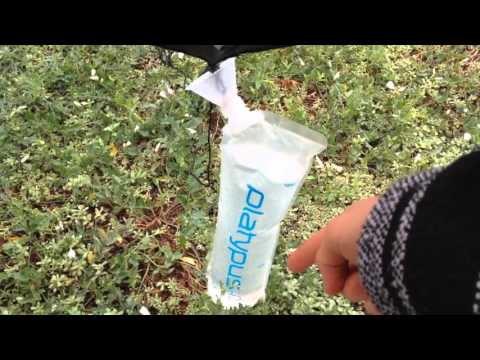Hennessy Hammock Water Collector and Tarp Tensioner System
Hennessy came out with their water collection and tarp tensioning system years ago as a simple but innovative way to collect water run-off from a tarp. The funnel cup clips onto the a mitten hook on the corner tie-out of Hennessy-brand tarp and has a threaded end that matches to most narrow-mouth water bottles. Not only can the system collect water, it acts as an automatic tensioning system, taking out the slack and pulling the tarp taut during the storm.
- Manufacturer: Hennessy Hammock, made in China
- MSRP: US$9.95 / pair —Free with online orders
Available Features/Specifications
Features
- Interior clip to attach to tarp
- Mesh screen to filter particulate matter
- Threaded end to match most small-mouthed water bottles
Specifications
- Size: 2.5 × 2.5 in (6.5 × 6.5 cm )
Weight
- 0.85 oz (24 g) per pair
Product Description
The Hennessy water collection and tarp tensioning system combines a funnel, attachment point, filter screen, and screw top to make a clever water collecting system. It’s simple, innovative, and brilliant. Inside the cup you’ll find a chevron-style clip that is used to connect to the tarp. Under the clip is the cone-shaped filter. The filter is a screen that can be popped out. The screw top fits most small-mouthed water bottles.

Recommendations and Review
I’ve been testing and using the Hennessy water collection system for years now. It’s a simple system that works amazingly well. In fact, the first time I really started testing it I was skeptical because an empty bottle, once attached, tends to turn the funnel up and it appears that it won’t work as well. Within a few minutes of even light rain, the water begins collecting and once their is enough weight, it levels the bottle and pulls it down.
As the bottle fills and pulls downward, the second effect comes into play: tarp tensioning. This is a great side-benefit of the cup and helps with stretchy tarps like silnylon.
Now let’s get to the gritty details.
On one hand, collecting rain water off your tarp means easy “free” water that doesn’t need to be treated. It can save some time in collecting water for the next day without much effort.
On the other hand, any debris on the tarp can pollute the water. The most damaging, bird poop, can have severe health risks.
The challenge, therefor, is to keep your tarp clean. Personally, I’ve only had birds poop on my tarp when I’ve had it up in the same spot for a few consecutive days. In the field, I’ve never had an issue with a bird roosting and pooping on any tarp. However, it is still something to be aware of. If you find bird poop on your tarp, wash it thoroughly. Organics, like leaf litter, pine needles, commonly fall on a tarp but do not pose a health risk. The screen in the collector will block out the large items. Sometimes dust and dirt gets blown on and can collect on a tarp. You can always use the rain to your advantage, waiting a minute or two for the rain to wash off any dust and then attach the collector and water bottle.
The other catch is that for locations where rain comes often enough that a nightly shower is expected, water is often plentiful and more easily obtained. I’m thinking specifically of a hike along the Appalachian Trail, rain forests (including the Pacific Northwest), etc.
In northern AZ, the monsoons are frequently an afternoon event, but we often get evening showers. But, again, based on the trip, it may not be of much value. For backpacking and camping, water is an essential daily resource that can’t be left to the whim of a rainstorm.
So, in a nutshell, yes the collectors work and they have a “cool gadget” factor, but unless you’re starring on a reality TV show and surviving on rainwater collection, they do have limited practical use if you’re on the move. It’s really makes more sense if you’re camping in a place for a few days (maybe) and have the reliability of consistent rain showers, or maybe in an emergency situation.
Tips
- To make it easier to clip/unclip the collector from the tarp, consider cutting the mitten hook so it remains open.
- Personally, I haven’t had problems using the stock mitten clips (uncut) because I push the funnel clip against the end of the mitten hook and it pops off easily.
- I store the water bottle lid inside the funnel so I don’t lose it. The tarp and tie-outs help prevent the lid from popping out.
- To channel more water directly to the funnel, consider “pinch-sewing” the edges of your tarp to create your own tarp gutters.
- Keep your tarp clean! Inspect for debris or bird poop and wash it thoroughly before using the collector.
Similar Products
- Kammok Dragonfly Tarp comes with a water tensioning and collection system that is integrated with the tarp.
Disclosure of material connection: The author (Derek Hansen) was provided with a free sample from the manufacturer for testing and evaluation purposes. The comments in this post (written & spoken) are of my own opinion, which I formed after personally handling the gear. I was under no obligation to publish a review of this item.








Leave a Reply to Vernon Cancel reply